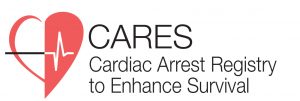Each year, 300,000 cases of out-of-hospital cardiac arrest (OHCA) occur in the United States. Almost two-thirds are treated by emergency medical services (EMS) providers. Community rates of OHCA survival are generally low (2%–40%). Quickly implementing the “chain of survival” is crucial to surviving OHCA, but many communities cannot measure how effectively EMS providers activate the chain. Without adequate performance measures, these communities lose opportunities to improve emergency cardiac care and save lives.
The Cardiac Arrest Registry to Enhance Survival (CARES) is a secure, web-based data management system created by the Centers for Disease Control and Prevention (CDC) collaborated with Emory University and the American Heart Association to help increase OHCA survival rates. Pennsylvania is one of 19 statewide participants in the registry, which also includes 64 communities in 23 states.
Communities enrolled in CARES enter local EMS and hospital data and generate their own reports. EMS agencies in Pennsylvania learn more about their system performance through de-identified aggregate statistics at the local, state, or national level and discover promising practices that could improve emergency cardiac care. Cardiac receiving hospitals enter patient outcomes into CARES, which will enable Pennsylvania communities to identify out-of-hospital cardiac arrest survival rates for the first time.
Helping Communities Identify Opportunities for Improvement
With a goal of increasing out-of-hospital SCA survival, PA CARES assists EMS, fire, first responders, hospitals, and the larger community to identify:
- Who is affected
- When and where cardiac arrests occur
- Which elements of the system are functioning well and those that could work more effectively
- How changes can be made to improve cardiac arrest outcomes
- How emergency cardiac treatment can be improved
Working Together to Improve Emergency Cardiac Care
The CARES system:
- Uses a secure Web database with restricted access for authorized users.
- Has software that collects and links data sources to create a single de-identified record for each OHCA event.
- Uses a simple, HIPAA-compliant methodology to protect confidentiality.
- Accepts a variety of input methods, such as uploaded data files or online data entry.
- Collects 9-1-1 computer-aided dispatch data for EMS response times.
- Allows longitudinal, internal benchmarking of key performance indicators.
- Provides multiple reporting features, including charts, graphs, and maps.
If you have any questions about this program, please send an email to kshoop@smemsc.org.
National Site: https://mycares.net
CARES 2016 Summary of National Data
